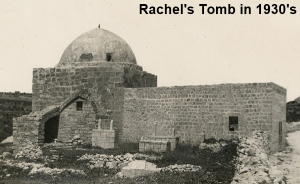Herod the Great was an egomaniac driven to maintain his power at all costs. Viewing Jesus as a rival to his throne, he tried to find out where he lived in Bethlehem in order to murder him. Unable to discover Christ's exact location (Matthew 2:8, 12, 16), he sent troops to the city to murder all males two years old or younger. According to Matthew, this mass execution in 5 B.C. fulfilled the words of Jeremiah the prophet which involved Rachel.
"A voice was heard in Ramah, lamentation and bitter weeping; Rachel weeping for her children; she refuses to be comforted for her children because they are not" (Matthew 2:18 quoting Jeremiah 31:15).
How are Ramah and Rachel linked to the original but lesser fulfillment of Jeremiah's words? How does this initial symbolism help us understand its full prophetic New Testament meaning as it relates to Jesus?
Original Meaning
Rachel, the beloved wife of Jacob, is considered by Jews to be the primary "mother" or founder of the nation of Israel (1906 Jewish Encyclopedia). This is in part due to her giving birth to Joseph, whose two sons (Ephraim and Manasseh), would become the nation's leading tribes. Biblical tradition states that after she died giving birth to Benjamin she was buried near Bethlehem (see Genesis 35:16 - 20).

Jeremiah's prophecy was given shortly before Babylon's final assault on Jerusalem and the Kingdom of Judah in 586 B.C. After the Babylonian victory, all those left alive (except the poorest, Jeremiah 39:10) are gathered in Ramah, a city in Benjamin's territory located five miles (8 kilometers) north of Jerusalem (Jeremiah 40:1). It is from Ramah that the captives from the kingdom are taken to Babylon.
In Jeremiah 31:15 Rachel is portrayed as crying not only for her literal descendants (Benjamites) but also, as the mother of Israel, for all those collected in Ramah. She laments for those taken captive out of their homeland as if "they are not" (Jeremiah 31:15) because the overwhelming majority will die in a foreign land. They will never return home as the captivity is foretold to last seventy years (29:10).
New Testament Fulfillment
Rachel, in the New Testament fulfillment of Jeremiah 31:15, again bitterly grieves at her loss. This time, however, it is literal children who "are not." These innocent offspring in Bethlehem are violently taken out of the land of the living by the murderous whim of a non-Israelite tyrant (Herod was an Edomite). Rachel's pain is symbolically further heighten, after the birth of Jesus, since her earthly remains are an eyewitness to the tragedy.
Bonus Facts!
Rachel is the first woman recorded in the Bible as dying in childbirth.
Jews consider the tomb of Rachel to be their third holiest site. The first holiest site is the Western Wailing Wall in Jerusalem and the second is the cave near Hebron where Abraham, Sarah and other family members are buried.
In both Jeremiah 31:15 and its New Testament fulfillment in Matthew 2:18, it was a non-Israelite (gentile) who caused Rachel to symbolically weep in Ramah. The Babylonians were, of course, gentiles. Herod the Great, who was an Idumean (Edomite), was also a non-Israelite when he commanded a mass slaughter after the birth of Jesus.